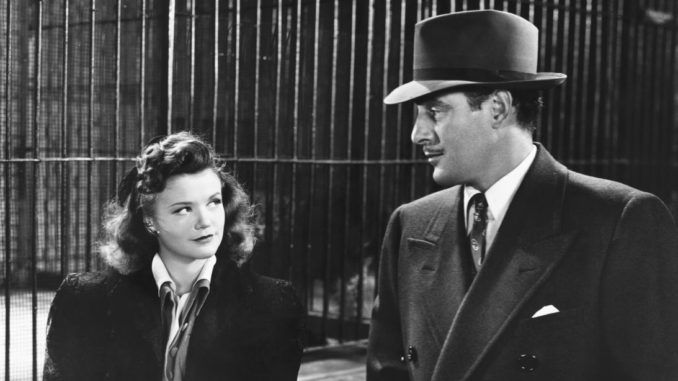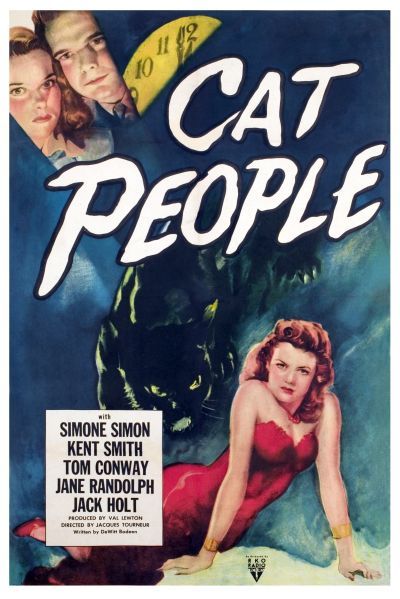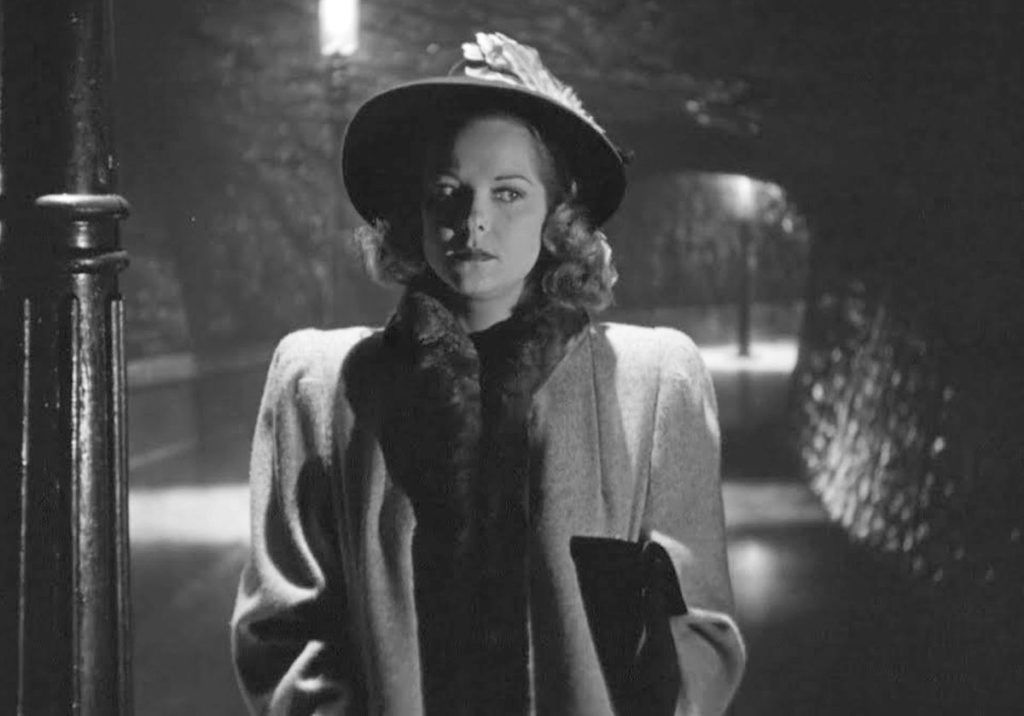
Rating: B
Dir: Jacques Tourneur
Star: Simone Simon, Kent Smith, Jane Randolph, Tom Conway
This was always going to be a tough one, because the 1982 remake is among my all-time favourites. I genuinely believe it to be superior to the original, for reasons I’ll get to later. This re-view did not change my opinion there. However, was I perhaps prejudiced on the way in, and looking to find fault with the movie? Guilty as charged, m’lud. A lot of what follows will therefore be somewhat at odds with the decent, respectful and appreciative grade above. For I will admit, this is a good movie, which crams a lot into a remarkably short 72 minutes, without seeming rushed. There’s no shortage of memorable moments, plus some gorgeous photography. And, yet… Something is missing.
Before we get into that, this was a clear winner for 1942. It had almost 20K more IMDb votes than any other horror movie of the year. It’s 7.2 rating was also a full half-point better than the next qualified candidate. There were a couple of interesting alternatives, which I may have reviewed by the time this is posted. The Night Has Eyes, released in the US as The Terror House, seems intriguing: “A pair of young teachers look into the disappearance of their friend in the Yorkshire Moors. They soon run across the man they suspect is the murderer (James Mason), and have to sit out a storm with him.” Rated H for horror in Britain, its release in June 1942 must have just escaped a ban on such movies, implemented later in the year.
 Back to Cat People, the first film resulting from Val Lewton being put in charge of managing RKO’s horror output earlier that year. There were three rules for him: all films had to cost $150,000 or less; each needed to run under 75 minutes; and he would be given the titles to be used by his bosses. At the time, the studio was on shaky ground and barely breaking even, thanks to commercial flops like Citizen Kane. Its major star, Ginger Rogers, was at the end of her contract, and RKO’s president George J. Schaefer had resigned in June. Lewton’s work was a major factor in turning things around: His first film, Cat People became RKO’s biggest hit that year, taking in almost thirty times its budget – which, at $134,000, was in line with studio demands.
Back to Cat People, the first film resulting from Val Lewton being put in charge of managing RKO’s horror output earlier that year. There were three rules for him: all films had to cost $150,000 or less; each needed to run under 75 minutes; and he would be given the titles to be used by his bosses. At the time, the studio was on shaky ground and barely breaking even, thanks to commercial flops like Citizen Kane. Its major star, Ginger Rogers, was at the end of her contract, and RKO’s president George J. Schaefer had resigned in June. Lewton’s work was a major factor in turning things around: His first film, Cat People became RKO’s biggest hit that year, taking in almost thirty times its budget – which, at $134,000, was in line with studio demands.
Immense credit is due to producer Lewton and writer DeWitt Bodeen, simply for putting effort into the scenario. It would have been easy to phone in such a task, horror forever being the red-headed step-child of cinema. But the run of movies which began with Cat People, were as impressive a stretch of low-budget quality in the genre, as any studio would manage until Hammer broke out at the end of the fifties. With a somewhat lurid title handed down from above, the pair still came up with an impressively detailed and subtle scenario, beginning in the medieval Balkans. The countryside fell into evil under the sway of the Mamelukes, and the population turned to the occult, until King John drove out the evil. Except, it hung around, as evil tends to.
You could actually read this as both anti-Muslim and anti-immigrant. Irena Dubrovna (Gallier) is recently arrived in New York from Serbia, but they’re not sending their best… Because she believes she is affected by the curse of her people, and is concerned that under, ah, “certain circumstances”, she’ll turn into a literal animal and rip apart the person she’s with. That’s most likely to be Oliver Reed (Smith), a marine engineer who has fallen for Irena. The pair get married, Oliver ignoring a series of red flags, such as creatures not wanting to be in Irena’s presence, or mysterious, catlike women coming up and calling her ‘Sister’. Oh, and Oliver actually being in love with work colleague Alice Moore (Randolph).
Let’s be blunt about the “certain circumstances”. Oh, the film may tiptoe around, hinting vaguely (it had to: the censors weren’t happy about the theme of unconsummated marriage). But it’s mostly sex. I mean, Oliver says, “When people in America are in love, or even think they’re in love, they’ve usually kissed long ago.” He’s not really talking about kissing, and isn’t fooling anyone. It’s just that, in 1942 Hollywood, the Hays Code was pretty much iron-clad, and this was as close as a film could get. This is where the remake leaves the original in its dust, because forty years later, it could put, front and centre, what Bodeen, Lewton and Tourneur could only nod at. Here, we get a totally chaste movie with sex at its core, while Paul Schrader’s remake is basically dripping. And not just from the humidity in New Orleans.
 Simon is the other area of weakness, her performance in severe need of more intensity. If she’s a cat, she’s hardly the panther into which she transforms. Apart from a foreign accent – and this in the days where Hollywood clearly considered “Europe” as a monolith – there’s no particular sense of otherness. I’ve met considerably weirder on the bus. And while we’re here, I’d be having a word with the Central Park Zoo about their security policies, which seem to allow anyone to wander in, at any hour of the day or night, guardrails be damned. Psychiatrist Dr. Judd (Conway) would also get a fast visit from the ethics committee, if he were operating in the present day.
Simon is the other area of weakness, her performance in severe need of more intensity. If she’s a cat, she’s hardly the panther into which she transforms. Apart from a foreign accent – and this in the days where Hollywood clearly considered “Europe” as a monolith – there’s no particular sense of otherness. I’ve met considerably weirder on the bus. And while we’re here, I’d be having a word with the Central Park Zoo about their security policies, which seem to allow anyone to wander in, at any hour of the day or night, guardrails be damned. Psychiatrist Dr. Judd (Conway) would also get a fast visit from the ethics committee, if he were operating in the present day.
However, as noted, there is still a lot to like here, and the lack of budget really does not affect the film much. Sure, you never see a transformation, and the panther attack stuff is almost non-existent. But the “Lewton bus” (above) is arguably the first jump scare in horror history, and hasn’t been done much better since. There’s good reason why the scene where Alice goes for a night swim, was copied almost wholesale by Schrader’s version, cinematographer John Bailey saying, “We didn’t think we could do it any better”. That’s still true, with the remake now closer in age to the original, than it is to the present day. I just made myself feel old.
This article is part of our October 2025 feature, 31 Days of Vintage Horror.
